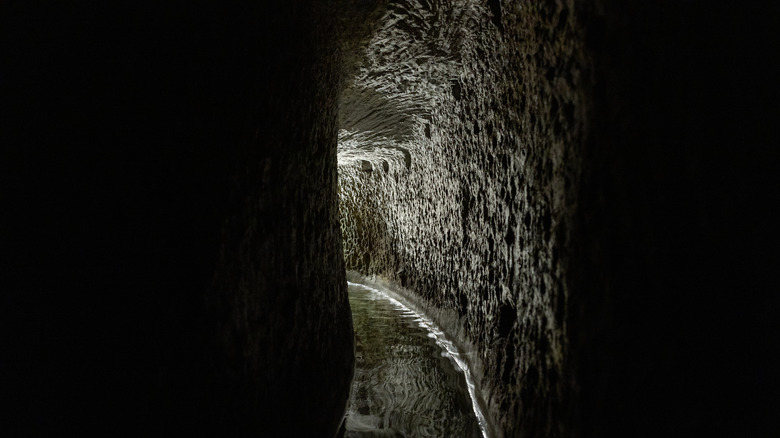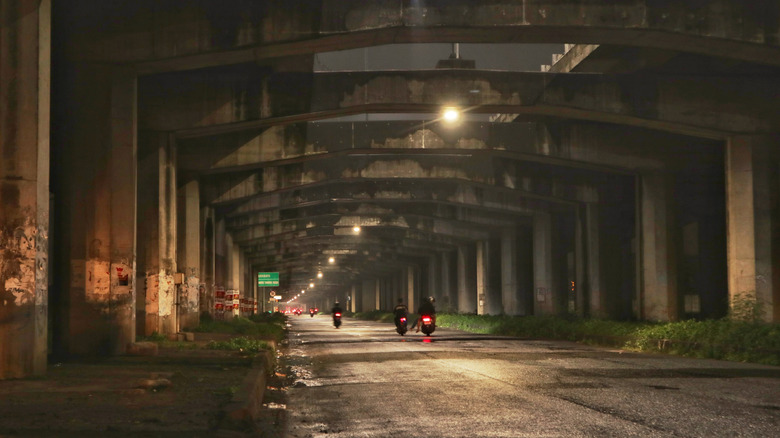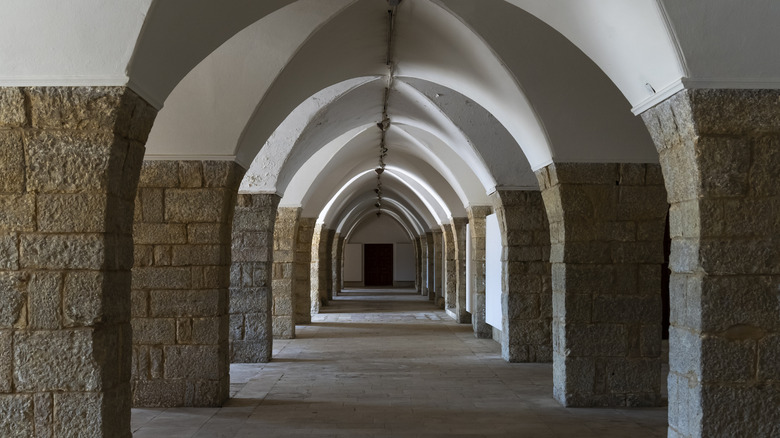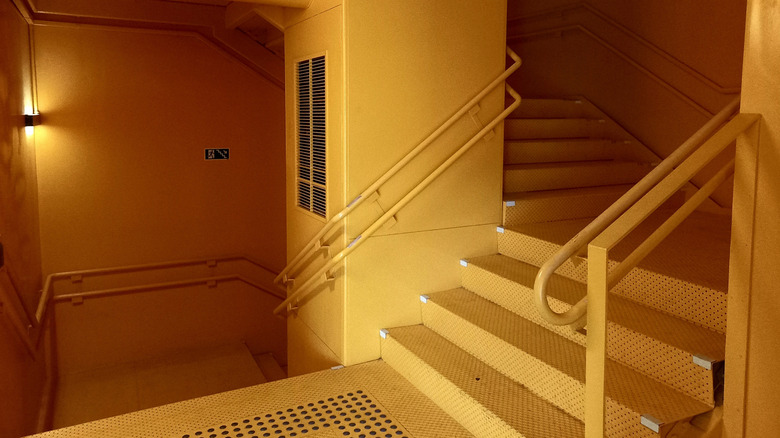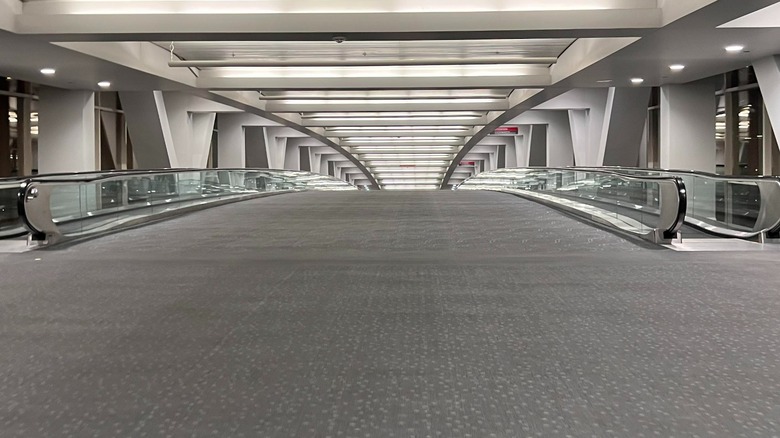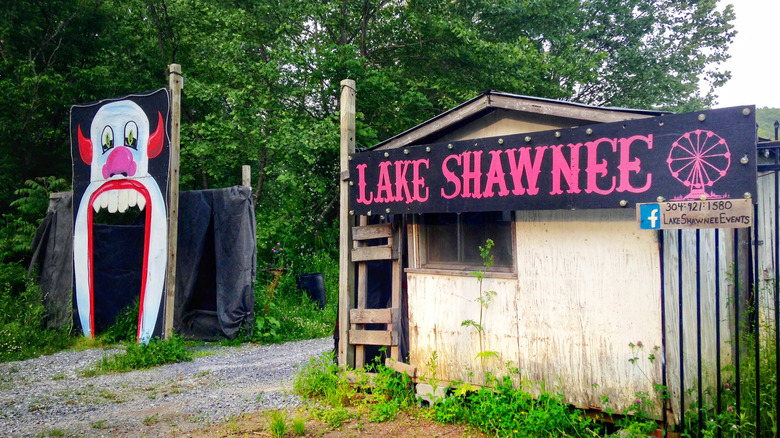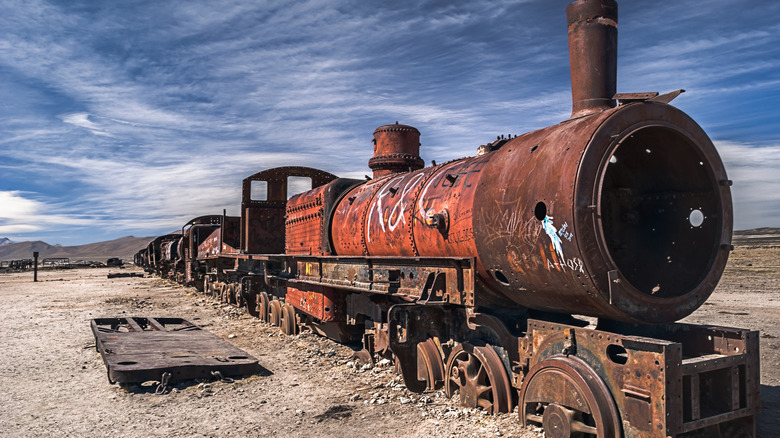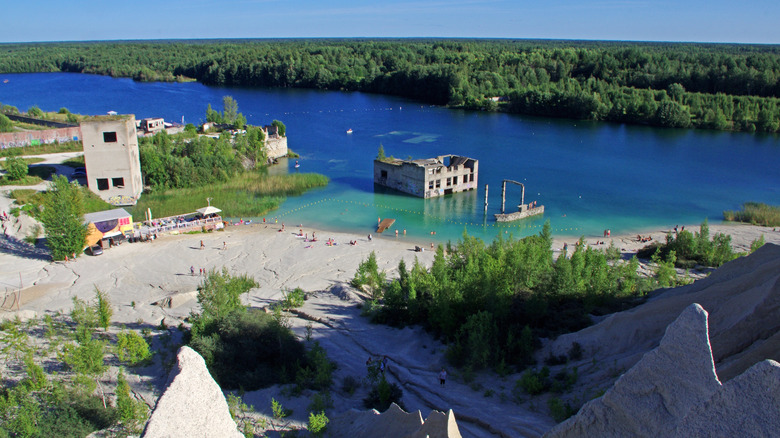Real Liminal Space Destinations You Can Visit Around The World
Exploring new places and learning about the history, culture, and people in some parts of the world far beyond your comfort zone is addictive. Even if you're more of a domestic tourist who loves to engage with unfamiliar destinations near your home, traveling can teach you a lot about yourself and the world around you. Indeed, traveling has a way of making us look inward to reflect on our lives, experiences, and mental frameworks. Many people grow significantly from exposure to new places and things. It's this hunger for adaptation and knowledge that often keeps travelers searching for their next great adventure.
But travel doesn't always have to be jammed with activities and events. Sometimes, the best itinerary is one that's wide open, allowing for the flow of a vacation to dictate what you do and where you go. In some travel plans, the lack of activities can sometimes be the entire point. There's a growing trend in modern travel to seek emptiness. Rather than lounging by the pool and being engrossed in a book to get away from the busy tempo of life, many are looking for travel destinations known as liminal spaces. Liminality is nothing new, but searching for it has become a modern feature of many bucket lists. We spoke with Dr. Sanam Hafeez, a New York City neuropsychologist and director of Comprehend the Mind, to understand what liminality is and why people seek these kinds of anti-activity experiences during their travels.
What is a liminal space?
We kicked off the conversation with some important grounding. First up, a discussion of liminality. Many travelers may not have heard this term before, but most people will be familiar with the concept. "A liminal space refers to a psychological or physical threshold—the in-between phase where a person is no longer in one state but has not yet fully transitioned into the next. This term describes unsettling or transitional spaces, such as abandoned shopping malls, that create a mild sense of discomfort or a sensation of frozen time," Dr. Hafeez explains.
Discomfort might seem like a strange thing to seek on a vacation. After all, your time away from work, school, and general responsibility is best served on adventure and enjoyment. But taking a deeper look at the way we travel illuminates something deep and important. As is the case with most voyages that bring travelers to new places, an inherent character of discomfort and the unknown play a massive role in the experience. Novelty is something that people everywhere hunger for, and liminality stands at the crossroads between the comfort of home and other known spaces and the unknown beyond. Basking in this intermediate space can be extremely rewarding.
Why are people seeking liminal spaces in their travel?
The newness of the experience is perhaps what's important here. Modern life has been wracked by a number of traumatic themes lately, and a fresh perspective can be intensely savory for people feeling the stress of the past half-decade. According to Dr. Hafeez, "Liminal spaces have gained popularity in recent years because they mirror the emotional uncertainty many people have felt—especially during and after the pandemic. These in-between environments, like empty malls or hallways, evoke a mix of nostalgia and unease that resonates deeply in times of transition."
Thinking about a time before the pandemic and standing in an eerily silent space that harkens back to the massive closures that dominated this era can deliver a real sense of power. This period was one of great stress for just about everyone. Millions of people around the world lost their lives to the virus, and those who made it through unscathed experienced something else. Graduates were unable to fully experience the transition — and accompanying liminality — from student to something else. Friends and coworkers fell out of touch with their social groups, and even those who didn't suffer medical setbacks directly were forced to make hard choices in treating other conditions. Entering these kinds of in-between spaces can provide a powerful means of grappling with the difficult feelings that were stirred up in many people's lives.
The value of liminal spaces for travelers and explorers
Liminal spaces exist all over the world. Some are found in abandoned areas that haven't been torn down and remain in a state of decay, while others are hulking structures that support a booming throng of activity at certain times of the day or year and empty out at other times. Dr. Hafeez says that a growing catalog of accounts and images of people exploring these places in real life has delivered a unique catharsis. "As people spend more time online, sharing these images has become a way to explore feelings of disconnection, change, and the strange comfort of the unfamiliar."
It's not just the places themselves that provide an important platform for introspection. "Psychologically, liminal spaces can also represent emotional or life transitions, such as graduating, ending a relationship, or changing careers, where your old identity doesn't quite fit anymore, but the new one hasn't taken full form. These spaces, while often uncomfortable, can be ripe for self-reflection, transformation, and growth." Visiting the destination in person or seeking pictures across the digital forest of internet communities can be a potent way to put your finger squarely on the emotions you're feeling during these times of change in your own life.
Mental well-being is a potential benefit, too, but careful attention to your needs is crucial
In addition to placing concrete words to the complex emotional responses that you may have to change in your life, there are a number of other benefits that travelers can find when exploring liminal destinations. With that being said, it's possible to evoke negative reactions, too. "Physical liminal spaces provide emotional advantages and disadvantages to people based on their personal mindset. The benefit of these spaces lies in their ability to provide a mental refresh. The emptiness and quiet in these spaces create an environment of introspection, which helps people manage their life changes. They can evoke a sense of timelessness that helps people step outside of their daily routines and gain perspective," Dr. Hafeez tells us.
"However," she notes, "for some, these same qualities may intensify feelings of loneliness, anxiety, or disorientation—especially if they're already in a vulnerable emotional state. The key is being aware of your mental landscape before immersing yourself in these spaces." Making sure you approach a visit to one of these kinds of spaces with a positive framework or the support of a close friend can help set you up for success.
How to get the most out of a visit to real world liminal spaces
With plenty of real places to choose from all around the world, it's actually fairly simple to build a travel itinerary that will bring you into contact with a powerful, mentally rewarding liminal space. "To fully benefit from visiting a physical liminal space, it helps to approach the experience with intention and openness," Dr. Hafeez offers.
Setting the tone early is crucial. "Travelers should start by slowing down—rather than rushing through, give yourself time to observe the quiet details of the space: the lighting, the textures, the absence of sound or activity. Leave distractions behind, including your phone, so your mind can engage with the environment uninterrupted. It's also helpful to visit during off-peak hours when the space is most likely to feel still and transitional," Dr. Hafeez adds.
It's of utmost importance to be still throughout this period to give structure to your emotions. Journaling, meditation, and other self-reflecting tools can help you make sense of everything you're feeling. This way, it won't just be another transitional space to pass through but an experience that might successfully clear murky waters. We'll now delve into physical liminal spaces you can visit to help put Dr. Hafeez's guidance into practice.
Denver International Airport
Denver International Airport is a great place to start when thinking about real-world liminal spaces. It is considered one of the United States' best airports to get stuck in during a long layover. Jumping off the page in a major way, Denver International is the second largest airport in the world by total area (52.4 square miles). The transit hub is so massive that it nearly doubles the size of the next largest airport. It's also considered the most sustainable airport in America, making it a great springboard for your travels if you're concerned about environmental protection. Conspiracy theories abound in Denver Airport, adding an even greater layer of mystique to its departure halls.
The sheer size of the airport makes it a wonderful spot for those looking for introspection. Dr. Hafeez tells us that airports can be a potent source of liminality, particularly late at night when the height of a day's passenger volume falls away. "Still operational but eerily quiet, they embody transition and movement," she notes. When sitting in any airport between evening flights, you can often find a quiet hideaway that offers a supreme palate for uninterrupted thought. Denver Airport has frequently been highlighted by travelers for its tranquility and cavernous emptiness when crowds die down.
Lake Shawnee Abandoned Amusement Park, West Virginia
Another fantastic source of liminal tourism can be found in closed amusement parks. Most people won't think about these kinds of spaces daily, but the reality is that a great abundance of abandoned recreational areas exists across the United States. Beyond the borders, the world is chock full of these kinds of failed entertainment projects. Some were closed after natural disasters rocked the community and damaged the facilities beyond repair. Others simply fell out of favor with guests and closed their doors. But a sprawling amusement park complex isn't one that former owners will be eager to invest even more money to dismantle once the gates have shut for good. This leaves most to stand as silent witnesses of the past. Dr. Hafeez states that these are "spaces designed for stimulation that, when empty, feel oddly frozen in time."
Lake Shawnee is an abandoned amusement park that you can actually visit with significant ease. Located in West Virginia, the amusement park closed its gates in 1966 but has remained in private hands up until the present. Its owners are more than happy to open the doors to curious visitors — regular tours are conducted on the grounds. The park is maintained in a basic sense to keep it as an active amusement site, but the abandoned vibe remains thick in the air. The site is even thought to be haunted, a characteristic that predates the construction of the entertainment facility, giving it a uniquely spooky undertone to the mix.
The London Heathrow Terminal 4 Holiday Inn Express
Hotels are another fascinating space that can deliver the liminal experience. You'll need to select a particular sort of atmosphere to tap into this feature, though. Dr. Hafeez notes that hotels with lower typical occupancy rates are a natural asset here. "Vacant hotel hallways—especially those with outdated décor or minimal lighting," are the kinds of environments you're looking for because "they feel suspended in time," she says.
There's a kind of "The Shining" vibe you'll be seeking when looking for a hotel that delivers on the liminality brief, but that doesn't mean you're only going to be looking to book a room in a hotel that's decidedly spooky. One great choice is the Terminal 4 Holiday Inn Express at London Heathrow Airport. When flying through England and using it as a stopover destination, staying in one of Heathrow's airport hotels can be a valuable option.
The Elizabeth Line and Heathrow Express are fast train options to bring you directly into the heart of London. Even with just a day in London, there's plenty to do and see. This particular hotel gives outside-is-inside vibes from the moment you walk in. The atrium is dimly lit, and the environment features a style all of its own making. The ceiling is painted as if you were standing outside, and the walls feature windows that appear to face the street rather than an indoor space. It's a surreal experience that can perfectly encapsulate the oddity of liminality.
Bolivia's Uyuni Train Graveyard
Transit terminals and the equipment that naturally populate them are another solid choice when seeking a liminal space. "Bus terminals or train stations at off-hours" are particularly interesting options, Dr. Hafeez says. "These places are built for motion, but when empty, they feel hauntingly still." The thronging crowds of transit hubs like New York's Penn Station rarely dissipate for long, but a late evening visit might give you some relief from the constant movement and deliver room for thought.
Another, perhaps even greater option is one that perfectly captures the essence of halted momentum. In Bolivia, a train graveyard stands not far from one of the country's most extravagant tourist destinations. The Uyuni Salt Flats feature a dreamy landscape that extends for thousands of miles (more than 6,500 square miles in total). The train graveyard is impacted significantly by its proximity to this salty environment. Bolivia was once the site of a giant mining boom, but that flurry of activity came to a crashing halt in the 1940s. Infrastructure was hastily created to support the industry, but when it went belly up, the equipment was no longer needed. Rather than repurposing, selling, or scrapping the trains, they were simply abandoned.
Today, visitors can see the decaying carcasses of trains strewn about the landscape. The metal bodies don't rot easily or quickly, but the salty air and decades of disuse have taken their toll. Additionally, the silent hallmarks of historical human interaction with the land are quietly being returned to the earth they once rushed across.
Rummu Quarry and Prison in Estonia
Rummu Quarry and Prison is unique in its liminality. Just west of Tallinn along Estonia's craggy coastline, Rummu is the former site of a Soviet-era work camp and prison. It was built in support of limestone mining in the area, and eventually, the prison site was flooded. This has left the remnants of Soviet control buried halfway underwater. The best way to explore this truly must-see Baltic nation historical site is with scuba gear strapped to your back.
Diving beneath the water comes with some caveats, though. The water is often cold, so you'll be best served with a dry suit rather than a traditional wet suit. Similarly, you'll need to be a certified diver to see the remnants of the facility in their totality. Tours and self-guided exploration of the parts that remain on lands are possible today, but diving beneath the water's surface provides an intensely liminal experience. There's no way to talk to those in your dive group (beyond the requisite hand signs), so you'll be left mostly with your thoughts as you traverse the wreckage in silence.
Craco, an Italian ghost town abandoned since 1980
Craco is an Italian village that delivers tremendous liminal energy to explorers looking for silent testaments to the past. Craco is a place with ancient roots, having been first settled definitively by the Greeks in the sixth century (although it has supported some habitation much earlier). The town was abandoned in 1963, however. An unfortunate sequence of seismic activity forced most of the people who called this community home to leave, and its final residents threw in the towel and left for good in 1980.
Guided tours are on offer from local tourist authorities, and visitors can expect a diverse selection of scenery. Doors and windows have long decayed in many buildings that remain standing here. This has melded the environments of carefully controlled indoor space with the untamed natural whims of the outdoors. Furniture and other items remain inside many homes within the community, and all kinds of growth can also be found indoors. The site delivers in spades on the transitional nature of the earthly environment. Left to its own devices, the ecosystem will reclaim just about anything it can reach, and Craco is slowly being given back to the earth in a powerful and meaningful way that can serve as a magnetic backdrop for a traveler's efforts at improved inner focus.
Blasket Islands off the Kerry coast of Ireland
The Blasket Islands are yet another example of an abandoned village. Located a short boat journey off the coast of Kerry in Ireland's west, the Blaskets were inhabited by industrious folk for generations. The first recorded inhabitants arrived on the Blaskets in 1597, and a population of roughly 150 called the area home by 1840. The Great Famine took its toll, as it did across the Irish mainland, however. A direct fall occurred as a result of crop failures and their consequences, but Ireland's emigrant pipeline ultimately hit the Blaskets with an outsized effect. By 1953, Great Blasket Island supported just 22 people, and it was abandoned by order of the Irish government that year.
The island is battered by unpredictable weather, and a lack of concrete communication links to the mainland leads to a precarious lifestyle that feels a world away. However, for the strong and confident swimmer, it lies within swimming distance from the mainland. Today, you can stay in a guesthouse on the island and hike around its steep perimeter. Both the open-air terrain and the dense (but very small) ruined field of the village's remains offer a fantastic window back in time that can be a phenomenal place to sit with your thoughts.
